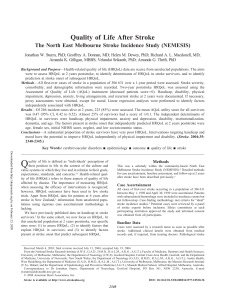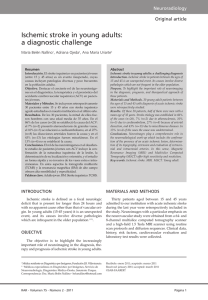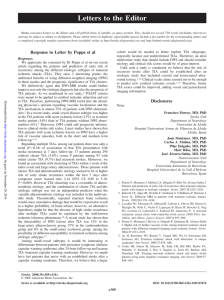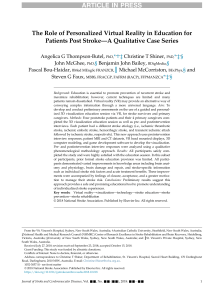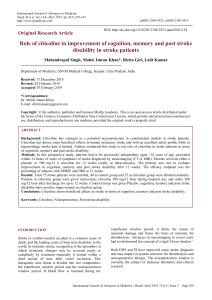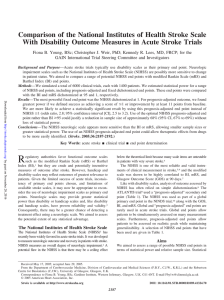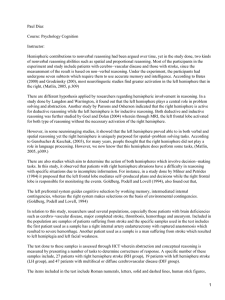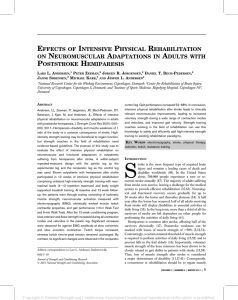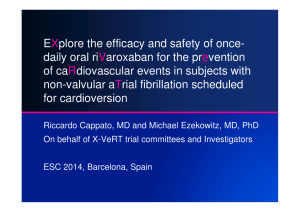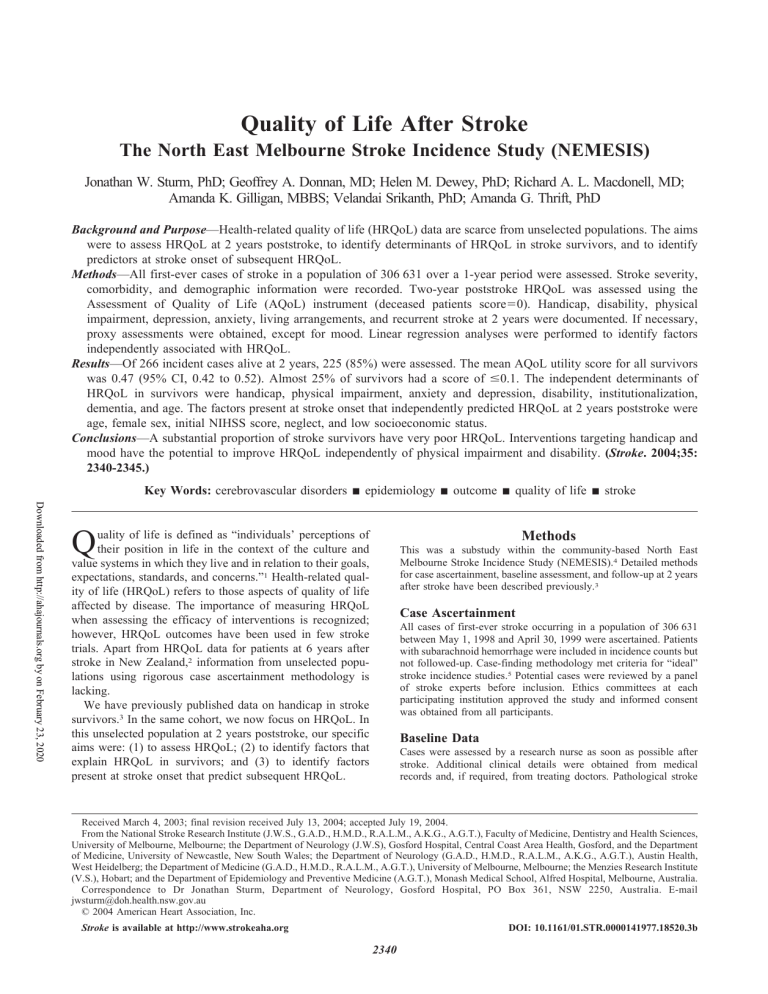
Quality of Life After Stroke The North East Melbourne Stroke Incidence Study (NEMESIS) Jonathan W. Sturm, PhD; Geoffrey A. Donnan, MD; Helen M. Dewey, PhD; Richard A. L. Macdonell, MD; Amanda K. Gilligan, MBBS; Velandai Srikanth, PhD; Amanda G. Thrift, PhD Background and Purpose—Health-related quality of life (HRQoL) data are scarce from unselected populations. The aims were to assess HRQoL at 2 years poststroke, to identify determinants of HRQoL in stroke survivors, and to identify predictors at stroke onset of subsequent HRQoL. Methods—All first-ever cases of stroke in a population of 306 631 over a 1-year period were assessed. Stroke severity, comorbidity, and demographic information were recorded. Two-year poststroke HRQoL was assessed using the Assessment of Quality of Life (AQoL) instrument (deceased patients score⫽0). Handicap, disability, physical impairment, depression, anxiety, living arrangements, and recurrent stroke at 2 years were documented. If necessary, proxy assessments were obtained, except for mood. Linear regression analyses were performed to identify factors independently associated with HRQoL. Results—Of 266 incident cases alive at 2 years, 225 (85%) were assessed. The mean AQoL utility score for all survivors was 0.47 (95% CI, 0.42 to 0.52). Almost 25% of survivors had a score of ⱕ0.1. The independent determinants of HRQoL in survivors were handicap, physical impairment, anxiety and depression, disability, institutionalization, dementia, and age. The factors present at stroke onset that independently predicted HRQoL at 2 years poststroke were age, female sex, initial NIHSS score, neglect, and low socioeconomic status. Conclusions—A substantial proportion of stroke survivors have very poor HRQoL. Interventions targeting handicap and mood have the potential to improve HRQoL independently of physical impairment and disability. (Stroke. 2004;35: 2340-2345.) Key Words: cerebrovascular disorders 䡲 epidemiology 䡲 outcome 䡲 quality of life 䡲 stroke Downloaded from http://ahajournals.org by on February 23, 2020 Q uality of life is defined as “individuals’ perceptions of their position in life in the context of the culture and value systems in which they live and in relation to their goals, expectations, standards, and concerns.”1 Health-related quality of life (HRQoL) refers to those aspects of quality of life affected by disease. The importance of measuring HRQoL when assessing the efficacy of interventions is recognized; however, HRQoL outcomes have been used in few stroke trials. Apart from HRQoL data for patients at 6 years after stroke in New Zealand,2 information from unselected populations using rigorous case ascertainment methodology is lacking. We have previously published data on handicap in stroke survivors.3 In the same cohort, we now focus on HRQoL. In this unselected population at 2 years poststroke, our specific aims were: (1) to assess HRQoL; (2) to identify factors that explain HRQoL in survivors; and (3) to identify factors present at stroke onset that predict subsequent HRQoL. Methods This was a substudy within the community-based North East Melbourne Stroke Incidence Study (NEMESIS).4 Detailed methods for case ascertainment, baseline assessment, and follow-up at 2 years after stroke have been described previously.3 Case Ascertainment All cases of first-ever stroke occurring in a population of 306 631 between May 1, 1998 and April 30, 1999 were ascertained. Patients with subarachnoid hemorrhage were included in incidence counts but not followed-up. Case-finding methodology met criteria for “ideal” stroke incidence studies.5 Potential cases were reviewed by a panel of stroke experts before inclusion. Ethics committees at each participating institution approved the study and informed consent was obtained from all participants. Baseline Data Cases were assessed by a research nurse as soon as possible after stroke. Additional clinical details were obtained from medical records and, if required, from treating doctors. Pathological stroke Received March 4, 2003; final revision received July 13, 2004; accepted July 19, 2004. From the National Stroke Research Institute (J.W.S., G.A.D., H.M.D., R.A.L.M., A.K.G., A.G.T.), Faculty of Medicine, Dentistry and Health Sciences, University of Melbourne, Melbourne; the Department of Neurology (J.W.S), Gosford Hospital, Central Coast Area Health, Gosford, and the Department of Medicine, University of Newcastle, New South Wales; the Department of Neurology (G.A.D., H.M.D., R.A.L.M., A.K.G., A.G.T.), Austin Health, West Heidelberg; the Department of Medicine (G.A.D., H.M.D., R.A.L.M., A.G.T.), University of Melbourne, Melbourne; the Menzies Research Institute (V.S.), Hobart; and the Department of Epidemiology and Preventive Medicine (A.G.T.), Monash Medical School, Alfred Hospital, Melbourne, Australia. Correspondence to Dr Jonathan Sturm, Department of Neurology, Gosford Hospital, PO Box 361, NSW 2250, Australia. E-mail jwsturm@doh.health.nsw.gov.au © 2004 American Heart Association, Inc. Stroke is available at http://www.strokeaha.org DOI: 10.1161/01.STR.0000141977.18520.3b 2340 Sturm et al subtype (ischemic stroke [IS], intracerebral hemorrhage) was determined using neuroimaging or autopsy findings.6 Patients without neuroimaging or autopsy were classified as undetermined. IS cases were further categorized using the Oxfordshire Community Stroke Project classification.7 Demographic data recorded included age, sex, country of birth, preferred language, living alone, and institutionalization (nursing home, hostel, or supported accommodation). Occupations of the patient and spouse were used to classify socioeconomic status (SES).8 The categories for SES ranged from 1 (highest) to 6 (lowest). Stroke severity markers recorded were dysphasia, loss of consciousness, neglect, and dense hemiparesis (loss of power against gravity in at least 1 limb) as determined using medical records and the National Institutes of Health Stroke Scale (NIHSS) examination. An acute NIHSS score was recorded prospectively when the patient was seen within 7 days, or retrospectively from the medical records. Comorbidities recorded were the presence of dementia, prestroke disability, and stroke risk factors (hypertension, diabetes, smoking, cardiac failure, atrial fibrillation, peripheral vascular disease, previous transient ischemic attack, and previous myocardial infarction). Dementia, hypertension, cardiac failure, peripheral vascular disease, previous transient ischemic attack, and previous myocardial infarction were defined as a known history. Smoking status was classified as current, ex, or never. Prestroke disability was defined as a prestroke Barthel Index score of ⬍20/20. Diabetes was defined as either a known history or a current presentation with fasting blood glucose ⱖ7.0 mmol/L. Atrial fibrillation was defined as either a known history or a current presentation confirmed on electrocardiography. Follow-up Downloaded from http://ahajournals.org by on February 23, 2020 Participants were assessed in a standardized face-to-face interview at 2 years after their index stroke. If severe cognitive impairment or dysphasia was present, proxy interviews from reliable informants were used, except for mood assessments. Interpreters were provided when required. Instruments HRQoL was assessed using the Assessment of Quality of Life (AQoL) instrument,9 a generic HRQoL utility instrument that includes 5 dimensions of HRQoL: independent living, social relationships, physical senses, psychological well-being, and illness. Scores from the first 4 dimensions, but not the illness dimension, are used to calculate an overall utility score. Each individual scale is weighted to extend between 0.0 (death) and 1.0 (full health). However, the overall utility score ranges from ⫺0.04 (worst possible HRQoL state) to 0.00 (death equivalent HRQoL state) to 1.00 (full HRQoL). The AQoL has been validated for use in the general population9,10 and in people with stroke.11 Handicap was assessed using the London Handicap Scale (LHS);12 physical impairment with the NIHSS;13 and disability with the Barthel Index.14 Disability the patient stated as not caused by stroke was also recorded. Mood impairment was assessed with the Irritability, Depression, Anxiety scale (IDA),15 a self-assessment measure of depression, anxiety, and “inward” and “outward” irritability. Stroke-like events in the previous 2 years were identified using a questionnaire. A panel of experts verified recurrent strokes using information from medical or nursing home records and from treating doctors. Analyses Student t test or 1-way ANOVA was used to determine the significance of differences in 2-year HRQoL scores between patients categorized according to demographic, stroke severity, comorbidity, and stroke subtype variables; 2-year impairment and disability scores; and presence of recurrent stroke. Univariable linear regression analyses were performed to identify factors present concurrently (ie, at the time HRQoL was assessed) associated with HRQoL in survivors. Multivariable linear regression analyses were performed, including those factors significant on Quality of Life After Stroke 2341 Figure 1. Distribution of AQoL utility scores in survivors at 2 years after first-ever stroke (n⫽225). univariable analysis, to identify factors independently associated with HRQoL. First, all assessments (proxy and nonproxy) were examined, and then nonproxy assessments alone were used to examine the effects of mood. Once the most parsimonious model was obtained by backwards stepwise regression, each excluded variable was entered again separately to test its contribution to the final model. NIHSS, Barthel, IDA and LHS scores, and age were entered as continuous variables. Similarly, univariable and then multivariable linear regression were performed to identify factors, present at stroke onset, that were independent predictors of HRQoL at 2 years after stroke. For these analyses, patients deceased at 2 years after stroke have a utility score of 0.0. Results Of 516 cases of first-ever stroke, 27 had subarachnoid hemorrhage and were ineligible for this study. The remaining 489 comprised 223 deceased at 2 years after stroke (46%) and 266 survivors. Of these survivors, 4 were found ⬎2 years after stroke, 38 refused participation, and 225 (85%) were assessed. The mean time to interview was 737 days (median, 731; range, 646 to 898). Of those assessed, 51% were male, 23% were institutionalized, 22% were living alone, 85% had IS, 12% had intracerebral hemorrhage, 3% had undetermined subtype, and the mean age was 71 years (95% CI, 69 to 73). Forty-seven (21%) had proxy assessments. There were no significant differences between those assessed and those eligible but not assessed in terms of age (P⫽0.7; Student t test) or sex, country of birth, stroke subtype, and stroke severity markers (all Pⱖ0.9; 2). No significant colinearity or interaction among variables entered into regression analyses was found. HRQoL in Survivors After Stroke The mean utility score for survivors was 0.47 (95% CI, 0.42 to 0.52). Eight percent of patients had HRQoL assessed as equivalent to, or worse than, death; and nearly one-quarter had a utility score of ⱕ0.1. These patients more often had proxy assessments than did patients with higher scores (Figure 1). Seventy-seven percent of patients with an AQoL utility score of ⱕ0.1 were not institutionalized at stroke onset. Patients’ scores ranged between 0.0 and 1.0 for each of the subscales. The mean subscale scores (which, unlike the utility 2342 Stroke October 2004 Figure 2. HRQoL of survivors grouped according to demographic factors, comorbidities and risk factors, and 2-year outcomes. *P⬍0.05, univariable linear regression. Downloaded from http://ahajournals.org by on February 23, 2020 score, have not been transformed to reflect community preferences) were independent living 0.59 (95% CI, 0.54 to 0.64), social relationships 0.8 (95% CI, 0.77 to 0.83), physical senses 0.88 (95% CI, 0.86 to 0.90), and psychological well-being 0.86 (95% CI, 0.84 to 0.88). The mean score for the illness domain (not used in utility score calculation) was 0.27 (95% CI, 0.24 to 0.30). HRQoL was associated with female sex, increasing age, institutionalization at stroke onset, low SES, dementia, preexisting disability,; and the presence at 2 years poststroke of greater physical impairment and disability, depression, anxiety, inward irritability, nonstroke-related disability, and institutionalization. Patients with recurrent stroke had worse HRQoL than those without further stroke; however, differences were not statistically significant. Univariable Relationships Between HRQoL and Demographics, Comorbidities, and 2-Year Outcomes in Survivors Independent Concurrent Determinants of HRQoL in Survivors The relationships between HRQoL in survivors and demographic factors, comorbidities, and outcomes at 2 years after first-ever stroke are summarized in Figure 2 and Tables I-IV (available online at http://www.strokeaha.org). Worse In the first analysis, mood scores were excluded (ie, both proxy and nonproxy assessments were included). The independent determinants were 2-year handicap, institutionalization at 2 years, dementia, and age (adjusted R⫽0.74). The Sturm et al TABLE 1. Independent Concurrent Determinants of HRQoL in Survivors at 2 Years After First-Ever Stroke, Including Mood Assessments Variable Mean Score  (95% CI) 2-year LHS 81 0.009 (0.007, 0.010) 2-year NIHSS 1.5 ⫺0.013 (⫺0.26, ⫺0.001) Depression 4.0 ⫺0.017 (⫺0.028, ⫺0.007) Anxiety 3.9 ⫺0.019 (⫺0.28, ⫺0.009) Multivariable, P ⬍0.001 0.028 0.001 ⬍0.001 2-year Barthel 17.8 0.012 (0.003, 0.020) 0.005 Age 68.6 ⫺0.023 (⫺0.004, 0.000) 0.019 LHS indicates London Handicap Scale; NIHSS, National Institutes of Health Stroke Score. Adjusted R2 for model⫽0.76, n⫽167. second analysis included mood scores (ie, using only data from nonproxy respondents). The independent determinants were 2-year handicap, disability and impairment, age, anxiety, and depression (Table 1). When recurrent stroke and the markers of initial stroke severity were added to the multivariable models, none was retained as independent determinants of HRQoL. Baseline Predictors of HRQoL Downloaded from http://ahajournals.org by on February 23, 2020 For this analysis, patients deceased at 2 years poststroke were included (utility score⫽0.0). The factors present at stroke onset significantly associated with HRQoL regression analyses are summarized in Table 2. Initial stroke severity markers, subtype, institutionalization at stroke onset, dementia, risk factors, and demographics were considered. Stroke severity markers, female sex, dementia, institutionalization, cardiac failure, low SES, and TACI subtype were significantly associated with worse HRQoL on univariable analysis. The independent determinants on multivariable regression were age, sex, initial NIHSS score, neglect, and SES. Discussion This is the second community-based study, with ideal methodology to ensure complete case ascertainment, to provide HRQoL data on stroke patients.2 The AQoL utility scores provide an estimate of the general communities’ views about the state of health the patient is experiencing. The distribution of scores (Figure 1) provides evidence that HRQoL is impaired for most survivors at 2 years poststroke. The mean utility for survivors (⬇0.5) suggests that people in the general community would rather give up half of their remaining years of life to live in full health than continue living with the health status of the average stroke survivor. The utilities obtained are similar to those reported elsewhere of 0.5 to 0.7 for mild to moderate stroke and ⱕ0.0 to 0.3 for major stroke.16 This is considerably lower than the median AQoL score of 0.86 found in a group of healthy elderly people living in the community in Melbourne (Graeme Hawthorne, Department of Psychiatry, The University of Melbourne, personal communication). Our findings are consistent with previous reports of reduced HRQoL poststroke, even among patients with good functional recovery.16 –26 A major finding was that 8% of patients had HRQoL assessed as equivalent to or worse than death, and that almost Quality of Life After Stroke 2343 TABLE 2. Baseline Predictors of HRQoL at 2 Years After Stroke Significant on Linear Regression Variable Ischaemic subtype† TACI PACI POCI LACI Dense hemiplegia Yes No Impaired consciousness Yes No Neglect Yes No Urinary incontinence Yes No Dysphasia Yes No Initial NIHSS 0–5 6–10 11–15 ⱖ16 Institution at onset Yes No Sex Male Female Age ⬍34 35–44 45–54 55–64 65–74 75–84 ⱖ85 Socioeconomic status 1 2 3 4 5 6 Cardiac failure Yes No Dementia Yes No Alcohol Never Mild Heavy Ex-heavy n* Mean AQoL (95%CI) Univariable P Multivariable P 76 111 67 68 0.06 (0.02, 0.11) 0.32 (0.25, 0.39) 0.38 (0.28, 0.47) 0.38 (0.29, 0.47) ⬍0.001 — 205 241 0.08 (0.06, 0.11) 0.37 (0.32, 0.42) ⬍0.001 — 153 294 0.05 (0.02, 0.08) 0.37 (0.29, 0.38) ⬍0.001 — 90 320 0.13 (0.08, 0.18) 0.29 (0.25, 0.33) ⬍0.001 0.002 132 308 0.05 (0.02, 0.07) 0.32 (0.28, 0.36) ⬍0.001 — 139 305 0.15 (0.10, 0.20) 0.28 (0.24, 0.32) ⬍0.001 — 190 75 44 102 0.45 (0.39, 0.50) 0.20 (0.14, 0.27) 0.06 (0.01, 0.10) 0.01 (⫺0.003, 0.03) ⬍0.001 ⬍0.001 76 372 0.05 (0.01, 0.08) 0.28 (0.24, 0.31) ⬍0.001 — 201 247 0.32 (0.27, 0.38) 0.17 (0.13, 0.20) ⬍0.001 ⬍0.001 11 7 15 41 102 153 119 0.61 (0.33, 0.89) 0.54 (0.16, 0.92) 0.57 (0.39, 0.75) 0.48 (0.36, 0.61) 0.32 (0.25, 0.39) 0.19 (0.14, 0.24) 0.04 (0.01, 0.07) ⬍0.001 ⬍0.001 90 65 32 66 26 61 0.41 (0.33, 0.50) 0.29 (0.21, 0.38) 0.23 (0.10, 0.36) 0.28 (0.20, 0.36) 0.23 (0.08, 0.37) 0.25 (0.17, 0.33) 0.005 ⬍0.001 88 354 0.10 (0.06, 0.16) 0.27 (0.24, 0.31) ⬍0.001 — 60 386 0.02 (⫺0.01, 0.06) 0.27 (0.23, 0.30) ⬍0.001 — 141 200 19 15 0.21 (0.16, 0.26) 0.32 (0.27, 0.37) 0.30 (0.14, 0.46) 0.29 (0.05, 0.53) 0.040 — *Number with available data. †71 ICH, 55 undetermined subtypes, differences among pathological subtypes non-significant. NIHSS indicates National Institutes of Health Stroke Score. Adjusted R2 for model⫽0.41, n⫽321 2344 Stroke October 2004 Downloaded from http://ahajournals.org by on February 23, 2020 one-quarter had a utility score of ⱕ0.1. Clearly, the outcome for a substantial proportion of patients who survive to 2 years is poor. The impairment in HRQoL of survivors was pronounced in the independent living domain of the AQoL that is used to assess basic and instrumental activities of daily living and ease of getting around the home and community. The low score in the illness domain implies that this group of patients is heavily reliant on medications, medical aids, and health professionals. Patients scored better, on average, in the domains of social relationships, physical senses, and psychological well-being. Other authors using the SF-36 have also found that physical well-being (ie, SF-36 Physical Functioning and Role Physical scales) is the component of HRQoL most affected after stroke.2,18,20,26 Similar to previous work at other time points, the factors present at 2 years poststroke that independently influenced HRQoL in survivors were physical impairment,21,22,25,27,28 disability,18,27–31 depression,18,22,25,29 –31 and age.18,21,28 We also found that handicap, anxiety, institutionalization, and dementia were independently associated with HRQoL, whereas others reported that cognition was an important factor.32 Social support has been identified as a determinant of HRQoL;29 –31 however, this was not specifically assessed in our study. We have previously found that disability, physical impairment, anxiety, and depression were also independent determinants of handicap.3 Therefore, addressing these factors may influence HRQoL either directly or indirectly through reducing handicap. Alleviating poststroke handicap (eg, rehabilitation, poststroke services, occupational and leisure therapy, environmental modification) may improve HRQoL; however, the effectiveness of these interventions is unclear. The factors at stroke onset that independently predicted HRQoL at 2 years poststroke (in deceased and surviving patients) were age, sex, initial NIHSS score, neglect, and low SES. These baseline factors did not add additional independent explanation of HRQoL in survivors when included in analyses with factors measured concurrently with HRQoL. However, the identification of these indicators of subsequent poor HRQoL may be useful to the clinician. That surviving TACI patients had significantly worse HRQoL than other subtypes is consistent with previous reports of increased mortality,7 dependence,7 impairment,33 and handicap34 in these patients. The lack of significant difference in HRQoL between survivors with IS and intracerebral hemorrhage is consistent with reports at 6 months21 and at 1 to 3 years poststroke.30 Because of our community-based design and high follow-up rate, it is likely that our sample population is representative of stroke patients as a whole. HRQoL was assessed with the AQoL for which validity in cross-sectional stroke studies has been demonstrated.11 Weaknesses of our study include lack of assessment of the influence of rehabilitation and social support on outcomes. Analyses were exploratory; therefore, some associations may be significant by chance, and results need validation in other cohorts. Patients may rate health status better than their proxies do;35 therefore, HRQoL may have been underestimated in our proxy assessments. Furthermore, the relationship between mood and HRQoL was not examined in patients with proxy assessments and may differ from that observed in patients responding themselves. The AQoL has several advantages as an outcome measure, providing a valid and sensitive measure of HRQoL and utility scores that can be used to calculate qualityadjusted life-years in economic analyses. Disability and handicap instruments do not allow death to be considered when baseline factors are used to predict outcome. The design of the AQoL means deceased patients score equals 0.0 (HRQoL equivalent to death), allowing an unbiased assessment of predictors of HRQoL. This makes the AQoL an attractive measure for stroke clinical trials. Additional validation of the instrument, particularly in use of proxy assessments, may further enhance its usefulness. Acknowledgements This work was supported by grants from the National Health & Medical Research Council (NHMRC), Victorian Health Promotion Foundation for High Blood Pressure Research and National Stroke Foundation. Lichun Quang provided assistance with database management and analysis. The contribution of the following research nurses is also gratefully acknowledged: Stephen Cross, Mary Staios, Cathy Taranto and Dennis Young. We thank Dr John Ludbrook (Biomedical Statistical Consulting Service) for assistance with the statistical analyses. J.W.S. was supported by an NHMRC postgraduate medical scholarship. References 1. WHOQOL group. Development of the World Health Organization WHOQOL-BREF quality of life assessment. Psychol Med. 1998;28: 551–558. 2. Hackett M, Duncan J, Anderson C, Broad J, Bonita R. Health-related quality of life among long-term survivors of stroke: results from the Auckland Stroke Study. Stroke. 2000;31:440 – 447. 3. Sturm JW, Donnan GA, Dewey HM, Macdonell RAL, Gilligan A, Thrift AG. Determinants of handicap after stroke: the North East Melbourne Stroke Incidence Study (NEMESIS). Stroke. 2004;35:715–720. 4. Thrift AG, Dewey HM, Macdonell RA, McNeil JJ, Donnan GA. Stroke incidence on the east coast of Australia: the North East Melbourne Stroke Incidence Study (NEMESIS). Stroke. 2000;31:2087–2092. 5. Sudlow CL, Warlow CP. Comparing stroke incidence worldwide: what makes studies comparable? Stroke. 1996;27:550 –558. 6. Thrift AG, Dewey HM, Macdonell RAL, McNeil JJ, Donnan GA. Incidence of the major stroke subtypes. Initial findings from the North East Melbourne Stroke Incidence Study (NEMESIS). Stroke. 2001;32: 1732–1738. 7. Bamford J, Sandercock P, Dennis M, Burn J, Warlow C. Classification and natural history of clinically identifiable subtypes of cerebral infarction. Lancet. 1991;337:1521–1526. 8. Australian Bureau of Statistics. Australian Standard Classification of Occupations, 2nd ed. Canberra: Australian Bureau of Statistics; 1997. 9. Hawthorne G, Richardson J, Osborne R. The Assessment of Quality of Life (AQoL) instrument: a psychometric measure of health-related quality of life. Qual Life Res. 1999;8:209 –224. 10. Hawthorne G, Richardson J, Day NA. A comparison of the Assessment of Quality of Life (AQoL) with four other generic utility instruments. Ann Med. 2001;33:358 –370. 11. Sturm JW, Osborne RH, Dewey HM, Donnan GA, Macdonell RA, Thrift AG. Brief comprehensive assessment of quality of life after stroke: the Assessment of Quality of Life (AQoL) instrument in the North East Melbourne Stroke Incidence Study (NEMESIS). Stroke. 2002;33: 2888 –2894. 12. Harwood RH, Gompertz P, Ebrahim S. Handicap one year after a stroke: validity of a new scale. J Neurol Neurosurg Psychiatry. 1994;57: 825– 829. 13. Brott T, Adams HP, Olinger CP, Marler JR, Barson WG, Biller J, Spilker J, Holleran R, Eberle R, Hertzberg V, Rorick M, Moomaw CJ, Walker M. Sturm et al 14. 15. 16. 17. 18. 19. 20. 21. 22. 23. Measurements of acute cerebral infarction: a clinical examination scale. Stroke. 1989;20:864 – 870. Mahoney F, Barthel D. Functional Evaluation: the Barthel Index. Md Med J. 1965;14:61– 65. Snaith RP, Constantopolous AA, Jardine MY, McGuffin P. A clinical scale for the self-assessment of irritability. Br J Psychiatry. 1978;132: 164 –171. Post PN, Stiggelbout AM, Wakker PP. The utility of health states after stroke. A systematic review of the literature. Stroke. 2001;32:1425–1429. Ahlsio B, Britton M, Murrray V, Theorell T. Disablement and quality of life after stroke. Stroke. 1984;15:886 – 890. Anderson CS, Laubscher S, Burns R. Validation of the Short-Form 36 (SF36) health survey questionnaire among stroke patients. Stroke. 1996; 27:1812–1816. Astrom M, Asplund K, Astrom T. Psychosocial function and life satisfaction after stroke. Stroke. 1992;23:527–531. Carod-Artal J, Egido JA, Gonzalez JE, de Siejas V. Quality of life among stroke survivors evaluated 1 year after stroke. Experience of a stroke unit. Stroke. 2000;31:2995–3000. de Haan R, Limburg M, Van der Muelen J, Jacobs HM, Aaronson NK. Quality of life after stroke. Impact of stroke type and lesion location. Stroke. 1995;26:402– 408. Jonkman EJ, De Weerd AW, Vrijens NLH. Quality of life after a first ischaemic stroke. Long-term developments and correlations with changes in neurological deficit, mood and cognitive impairment. Acta Neurol Scand. 1998;98:169 –175. Kauhanen M-L, Korpelainen JT, Hiltunen P, Nieminen P, Sotaniemi KA. Domains and determinants of quality of life after stroke caused by brain infarction. Arch Phys Med Rehabil. 2000;81:1541–1546. Quality of Life After Stroke 2345 24. Lai S-M, Studenski S, Duncan PW, Perera S. Persisting consequences of stroke measured by the Stroke Impact Scale. Stroke. 2002;33:1840 –1844. 25. Neau J-P, Ingrand P, Mouille-Brachet C, Rosier M-P, Couderq C, Alvarez A, Gil R. Functional recovery and social outcome after cerebral infarction in young adults. Cerebrovasc Dis. 1998;8:296 –302. 26. Viitanen M, Fugl-Meyer KS, Bernspang B, Fugl-Meyer A. Life satisfaction in long-term survivors after stroke. Scand J Rehab Med. 1988; 20:17–24. 27. Kwa VIH, Limburg M, de Haan RJ. The role of cognitive impairment in the quality of life after ischaemic stroke. J Neurol. 1996;243:599 – 604. 28. McEwen S, Mayo N, Wood-Dauphinee S. Inferring quality of life from performance-based measures. Disability and rehabilitation. 2000;22: 456 – 463. 29. Clarke P, Marshall V, Black SE, Colantonio A. Well-being after stroke in Canadian seniors. Findings from the Canadian study of health and aging. Stroke. 2002;33:1016 –1021. 30. Kim P, Warren S, Madill H, Hadley M. Quality of life of stroke survivors. Quality of Life Research. 1999;8:293–301. 31. King RB. Quality of life after stroke. Stroke. 1996;27:1467–1472. 32. Clarke PJ, Black S, Badley E, Lawrence J, Williams J. Handicap in stroke survivors. Disabil Rehabil. 1999;21:116 –123. 33. Hajat C, Dundas R, Stewart JA, Lawrence E, Rudd AG, Howard R, Wolfe CDA. Cerebrovascular risk factors and stroke subtypes. Differences between ethnic groups. Stroke. 2001;32:37– 42. 34. Sturm JW, Dewey HM, Donnan GA, Macdonell RAL, McNeil JJ, Thrift AG. Handicap after stroke: how does it relate to disability, perception of recovery, and stroke subtype? Stroke. 2002;33:762–768. 35. Dorman P, Waddell F, Slattery J, Dennis M, Sandercock P. Are proxy assessments of health status after stroke with the EuroQol Questionnaire feasible, accurate, and unbiased? Stroke. 1997;28:1883–1887. Downloaded from http://ahajournals.org by on February 23, 2020
